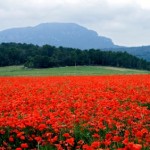News
Poppies
 In the run up to Remembrance Day on November 11th, the annual Poppy Day Appeal has been getting underway. But how many of us know why this simple flower has become synonymous with the end of the First World War and all those who fought and died?
In the run up to Remembrance Day on November 11th, the annual Poppy Day Appeal has been getting underway. But how many of us know why this simple flower has become synonymous with the end of the First World War and all those who fought and died?
For centuries, the poppy has been associated with peace, sleep and death, as far back as the Ancient Greeks. The flower’s association with sleep was also popularised in the 1900 children’s novel The Wonderful Wizard of Oz where fields of poppies were said to put travellers into a deep sleep.
In regards to Remembrance Day, the poppy has become a symbol of peace and death. It was first associated with the end of the First World War via the poem, “In Flanders Fields,” by the Canadian surgeon and soldier John McCrae. After the war, the only thing that grew in the devastated Flanders’ Field was poppies. The seeds of the poppy can lie dormant in the soil for years before finally germinating once the soil has been disturbed. As such, they were often seen growing on the graves of fallen soldiers.
The idea of wearing a red poppy in remembrance was started by an American YWCA worker by the name of Moina Michael, who was inspired by McCrae’s poem. After fashioning a silk poppy, she encouraged others to do the same as a mark of respect for those lost during the war. On November 11th, 1921 the First British Legion Poppy Day Appeal was held to raise money for those affected by the war and the tradition has been held every year ever since.
In the UK, the red poppy is worn by members of the public, politicians, celebrities and military personel throughout October right up until November 11th. On this day, a two-minute silence is held at precisely 11am to signify the moment in 1918 when the guns finally fell silent.

